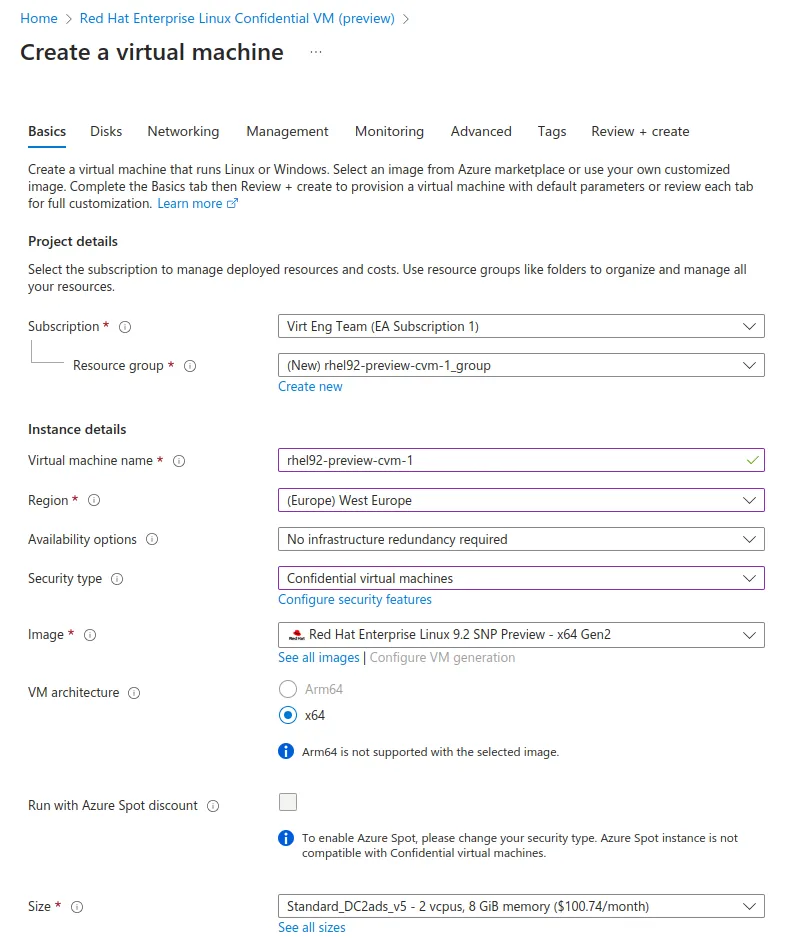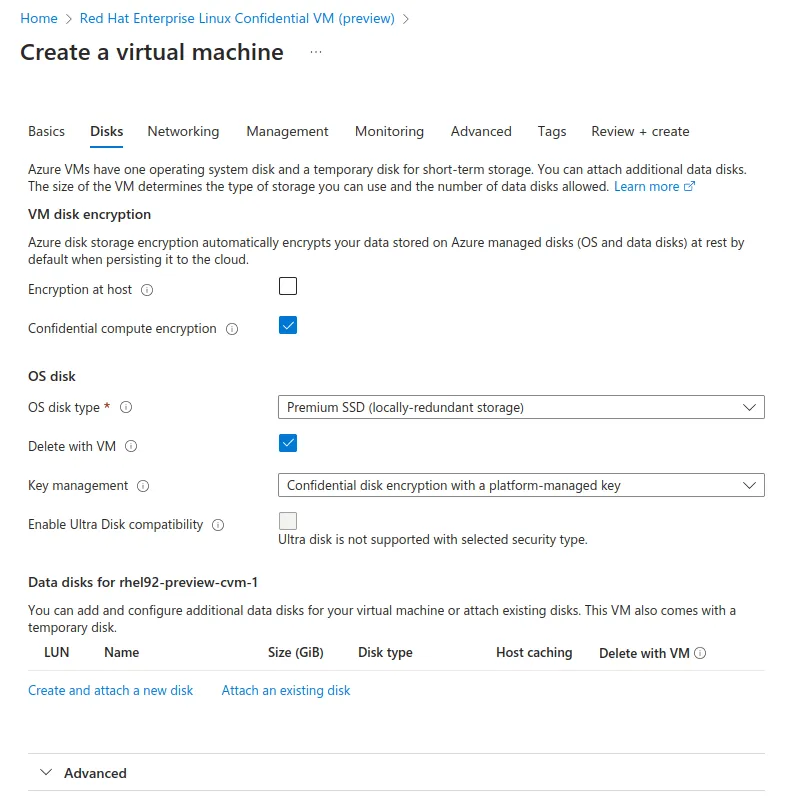With the release of Red Hat Enterprise Linux 9.2 (RHEL), it's possible to run the Technology Preview of RHEL on an Azure confidential virtual machine (CVM). In a previous article, I provided the high-level requirements for a Linux operating system to support a CVM use-case, as well as the changes made to the RHEL 9.2 operating system to support the features provided by Azure CVMs to ensure data confidentiality. In this article, I focus on how to get access to the CVM Preview image, and how to launch an Azure CVM using that image.
Get the CVM Preview image
In May 2023, Microsoft announced the availability of a RHEL 9.2 Preview confidential image tailored for AMD SEV-SNP CVMs on Azure. The support for Azure CVMs is a Technology Preview feature of Red Hat Enterprise Linux 9.2, developed in close collaboration between Red Hat and Microsoft. The "Technology Preview" status of the feature means that at this moment it's not suitable for production environments, but you can use it for non-production workloads. This gives you the opportunity to provide invaluable feedback and suggestions. The main goal of the Technology Preview is to verify that the feature works well for customer use-cases when it becomes fully supported in a future Red Hat Enterprise Linux release.
Running Azure CVM with RHEL 9.2 Preview confidential image
Once you've signed up for access to the RHEL 9.2 Preview confidential image, you can get the image using this direct link.

When creating a new Confidential VM using Azure Portal, make sure you set Security type to Confidential virtual machines, using one of the SEV-SNP CVM instance types (DCasv5, ECasv5) for Size setting.

To ensure data protection at rest, full disk encryption at the guest's side must be enabled. To do that, enable Confidential compute encryption in the Disks tab:

CVM instances may not be available in all Azure regions.
VM configuration
As a CVM owner, verify that your guest is running inside a genuine AMD SEV-SNP virtual machine. Microsoft provides documentation on Azure Confidential VM attestation. With RHEL 9.2 CVM Preview image, the basic test can be performed with the following sequence:
- In the guest, install the required packages:
$ sudo yum -y install jq
- Get the VCEK certificate from the metadata endpoint:
$ curl -H Metadata:true http://169.254.169.254/metadata/THIM/amd/certification > vcek $ cat ./vcek | jq -r '.vcekCert ' > ./vcek.pem
- Get get SNP report from the vTPM NVRAM
$ sudo tpm2_nvread -C o 0x01400001 > ./snp_report.bin $ sudo dd skip=32 bs=1 count=1184 if=./snp_report.bin of=./guest_report.bin
- Copy the vcek.pem and guest_report.bin files to a trusted environment, which can be, for instance, an on-premises RHEL 9 installation. In this example, files are placed in the ~/cvm_data directory on the target host.
- Install the snpguest tool:
(trusted)$ sudo yum -y git cargo rust (trusted)$ git clone https://github.com/virtee/snpguest.git (trusted)$ cd snpguest (trusted)$ cargo build
- Validate the VCEK certificate:
(trusted)$ target/debug/snpguest fetch ca Milan ~/cvm_data/ (trusted)$ target/debug/snpguest verify certs ~/cvm_data/ The AMD ARK was self-signed! The AMD ASK was signed by the AMD ARK! The VCEK was signed by the AMD ASK!
- Validate guest report:
(trusted)$ target/debug/snpguest verify signature ~/cvm_data/ \ -a ~/cvm_data/guest_report.bin VCEK signed the Attestation Report! (trusted)$ target/debug/snpguest verify tcb ~/cvm_data/ \ -a ~/cvm_data/guest_report.bin Reported TCB Boot Loader from certificate matches the attestation report. Reported TCB TEE from certificate matches the attestation report. Reported TCB SNP from certificate matches the attestation report. Reported TCB Microcode from certificate matches the attestation report. Chip ID from certificate matches the attestation report.
This is a simplified procedure and may, in some cases, require modification. In particular, there's no verification that the provided guest report was generated for this particular instance and not somewhere else. For the additional information on Azure Attestation, refer to the documentation provided by Microsoft.
Conclusion
The RHEL 9.2 Preview confidential image is currently a Technology Preview in RHEL 9, and not yet meant for production workloads, but it's an important indication of the future of cloud computing. If you're interested in Confidential VM technology, try it out and give us feedback on what you find. Let us know whether the image works for your use cases and what you would like to see in the future RHEL releases!
Sull'autore
Altri risultati simili a questo
Ricerca per canale
Automazione
Novità sull'automazione IT di tecnologie, team e ambienti
Intelligenza artificiale
Aggiornamenti sulle piattaforme che consentono alle aziende di eseguire carichi di lavoro IA ovunque
Hybrid cloud open source
Scopri come affrontare il futuro in modo più agile grazie al cloud ibrido
Sicurezza
Le ultime novità sulle nostre soluzioni per ridurre i rischi nelle tecnologie e negli ambienti
Edge computing
Aggiornamenti sulle piattaforme che semplificano l'operatività edge
Infrastruttura
Le ultime novità sulla piattaforma Linux aziendale leader a livello mondiale
Applicazioni
Approfondimenti sulle nostre soluzioni alle sfide applicative più difficili
Serie originali
Raccontiamo le interessanti storie di leader e creatori di tecnologie pensate per le aziende
Prodotti
- Red Hat Enterprise Linux
- Red Hat OpenShift
- Red Hat Ansible Automation Platform
- Servizi cloud
- Scopri tutti i prodotti
Strumenti
- Formazione e certificazioni
- Il mio account
- Supporto clienti
- Risorse per sviluppatori
- Trova un partner
- Red Hat Ecosystem Catalog
- Calcola il valore delle soluzioni Red Hat
- Documentazione
Prova, acquista, vendi
Comunica
- Contatta l'ufficio vendite
- Contatta l'assistenza clienti
- Contatta un esperto della formazione
- Social media
Informazioni su Red Hat
Red Hat è leader mondiale nella fornitura di soluzioni open source per le aziende, tra cui Linux, Kubernetes, container e soluzioni cloud. Le nostre soluzioni open source, rese sicure per un uso aziendale, consentono di operare su più piattaforme e ambienti, dal datacenter centrale all'edge della rete.
Seleziona la tua lingua
Red Hat legal and privacy links
- Informazioni su Red Hat
- Opportunità di lavoro
- Eventi
- Sedi
- Contattaci
- Blog di Red Hat
- Diversità, equità e inclusione
- Cool Stuff Store
- Red Hat Summit

